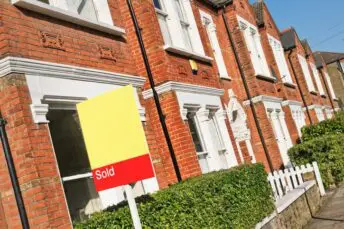House Price Watch Apr 2022
Average annual house price growth slowed slightly but remains in double digits. Buyer demand remains high and with not enough properties available on the market, sellers are able to sell faster and for ever increasing asking prices. Looking ahead, headwinds including the rising cost of living and rising mortgage rates are expected to slow housing market activity and house price growth later this year.
What’s happening nationally
House prices are up on average +0.3% in the past month and +10.9% in the past year.
Indices based on:
Land Registry – registered property transactions in March.
Nationwide & Halifax – mortgage valuations in April.
Rightmove – asking prices posted on Rightmove in April.
*Rightmove is not included in the index average as the basis for its index is different (asking price vs agreed sale price)
| Index reports: | Monthly change | Annual change |
|---|---|---|
| Land registry | +0.3% | +9.8% |
| Nationwide | +0.3% | +12.1% |
| Halifax | +1.1% | +10.8% |
| Rightmove | +1.6% | +9.9% |
| Average change | +0.6% | +10.9% |
House prices in your area
Monthly changes in house prices have been mixed over the past month with some areas seeing a continued rise and others seeing some drops.
Most areas of the UK have seen double digit house price growth over the past year.
The exceptions are London (+4.8%), Scotland (+8.0%), the North East (+8.7%) and Yorkshire & Humber (+9.0%).
Average house prices are highest in London and lowest in the North East.
House price growth also varies by property type. Detached homes have seen the biggest rise (+13.7%) and flats/ maisonettes the smallest (+4.0%) according to Land Registry data. This may reflect regional price differences (more flats in London), as well as, demand – higher demand for bigger properties and fewer properties of this type available for sale over the past year.
| UK Region | Average price £ | Monthly change | Annual change |
|---|---|---|---|
| England | |||
| Nothern Ireland | |||
| Scotland | |||
| Wales | |||
| North West | |||
| Yorkshire and The Humber | |||
| North East | |||
| West Midlands | |||
| East Midlands | |||
| South West | |||
| East of England | |||
| South East | |||
| London |
| UK City | Average price | Annual change |
|---|---|---|
Market Monitor
Transactions lower than last March but higher than is typical for this time of year.
Continues to be higher buyer demand than supply of homes available for sale, putting upward pressure on prices.
Time to sell accelerates in March.
How busy is the market?
- Not busy
- Normal
- Very busy
- Transactions lower than last March but higher than is typical for time of year
- Total transactions in March 115K
- +2.6% from last month
- -36% lower than March last year
Homes for sale vs homebuyers
- Good availability of homes
- Normal
- Shortage of homes
- Buyer enquiries up (+9% RICS); buyer demand continues to rise
- Seller enquiries steady (-2% RICS)
- Average stock per agent 42; up slightly (incl under offer/ Sold STC Rightmove)
Average speed of sale
- Fast
- Normal
- Slow
- 33 days to find a buyer down from 36 days last month (12 month average 41 days Rightmove)
What the experts say
Rightmove

“The price of property coming to market has hit a new record high for the third consecutive month. Prices have risen over the last three months by £19,082. This is the largest three-month price increase that Rightmove has ever recorded, with high buyer demand enabling sellers to ask and achieve ever higher prices. With not enough property available on the market, sellers are able to find a buyer quicker than ever previously seen by Rightmove, and twice as quickly as in the same period in the more normal market of 2019. This momentum is despite the growing economic headwinds, though we forecast that these headwinds will slow the pace of price rises as the year progresses.”
Nationwide

: “This is the 11th time in the past 12 months that the annual growth rate has been in double digits. Activity has remained solid with mortgage approvals continuing to run above pre-Covid levels. With the stock of homes on the market still low, this has translated into continued upward pressure on house prices. Nevertheless, it is surprising that conditions have remained so buoyant, given mounting pressure on household budgets which has severely dented consumer confidence and we expect the housing market to slow in the quarters ahead. The squeeze on household incomes is set to intensify with inflation expected to rise further, perhaps reaching double digits in the quarters ahead if global energy prices remain high. The Bank of England is likely to raise interest rates further, which will also exert a drag on the market if this feeds through to mortgage rates.”
Halifax

“This was the 10th consecutive month that property values have increased, the longest run of continuous gains since the end of 2016. Housing transactions and mortgage approvals remain above pre-pandemic levels and the continued growth in new buyer enquiries suggests activity will remain heightened in the short-term. The imbalance between supply and demand persists, with an insufficient number of new properties coming onto the market to meet the needs of prospective buyers and strong competition to secure properties driving up prices. However, the headwinds facing the wider economy cannot be ignored. The house price to income ratio is already at its highest ever level, and with interest rates on the rise and inflation further squeezing household budgets, it remains likely that the rate of house price growth will slow by the end of this year.”
Zoopla (Hometrack)

“House prices are being pushed up as buyer demand remains strong in the face of more constrained supply. Higher demand has also driven more transactions, with current levels of sales agreed running more than 20% higher than pre-pandemic levels. The supply of homes newly listed for sale has started to rise, and is currently running at 3% above the 5-year average. This is a modest rise, and it will take some time yet to unwind the significant shortage of stock for sale, which is currently sitting some 40% below the 5- year average. The economic headwinds which are already being felt in households across the country, will start to have more a material impact on the housing market in H2, putting some downward pressure on house price growth. These headwinds include the rising cost of living, and the rising cost of mortgage borrowing.”
RICS

“The April 2022 RICS UK Residential Survey results point to a modestly positive trend in new buyer demand remaining in place, alongside a generally stable picture for agreed sales. This, combined with a flat trend in fresh listings and still low stock levels, means that house prices continue to be pushed higher across all parts of the UK.”





